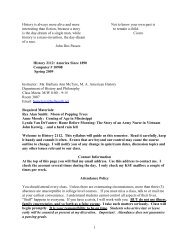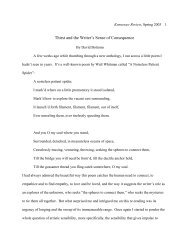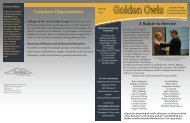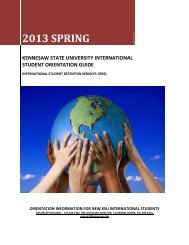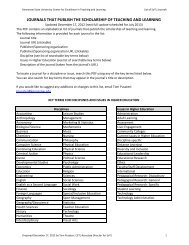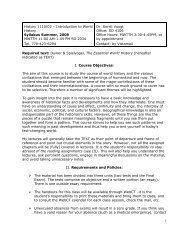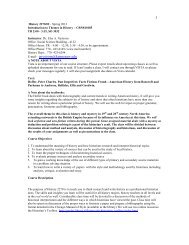Food, Gender and Cultural Hegemony - Kennesaw State University
Food, Gender and Cultural Hegemony - Kennesaw State University
Food, Gender and Cultural Hegemony - Kennesaw State University
You also want an ePaper? Increase the reach of your titles
YUMPU automatically turns print PDFs into web optimized ePapers that Google loves.
Cualli 129<br />
role of food <strong>and</strong> cuisine in the creation of creole identity <strong>and</strong> a<br />
“national cuisine”. (Pilcher ix)<br />
I. <strong>Food</strong>, Conquest <strong>and</strong> Culture<br />
The relationship of cuisine <strong>and</strong> shared meals to social organization has been<br />
noted by anthropologists as far back as Ernest Crawley (1869-1924). W. Robertson<br />
Smith (1846-94) emphasized the community bonds created through the sharing of<br />
food (discovered originally through analysis of the sacrificial meal). He argued that<br />
"the act of eating <strong>and</strong> drinking together is the solemn <strong>and</strong> stated expression of the fact<br />
that all those who share the meal are brethren, <strong>and</strong> that all the duties of friendship <strong>and</strong><br />
brotherhood are implicitly acknowledged in their common act" (Robertson Smith 247-<br />
48). A. R. Radcliffe-Brown saw the "getting of food" as a social activity, <strong>and</strong><br />
underlined the social function of food in socialization <strong>and</strong> maintenance of the social<br />
system. Taking this further Audrey Richards wrote about "the way a transaction in<br />
food acted as an indicator of social relations. For example, "the preparation of<br />
porridge…is the woman's most usual way of expressing the correct kinship sentiment<br />
towards her different male relatives," (Richards 127; Goody 13).<br />
Claude Levi-Strauss <strong>and</strong> Mary Douglas looked at food <strong>and</strong> how it was<br />
processed or cooked to discern meaning <strong>and</strong> a kind of language about social relations.<br />
Levi-Strauss argued that the ritual role of fire in the transformation of food made it a<br />
"human" endeavor. Douglas viewed the meal as a ritual act that includes elements of<br />
all other rituals <strong>and</strong> constitutes a social language about identity <strong>and</strong> connection (Levi-<br />
Strauss 1970; Douglas 1971).<br />
“The autonomy of the cultural” is the core of a debate among anthropologists<br />
about whether human cultures are formulated out of practical needs <strong>and</strong> environmental<br />
availability or if they are created through “symbolic, meaningful or cultural reasons<br />
which structure utility,” (Goody 32; Magagna 65). Carole Counihan recently defined<br />
food as a “part of culture that is central, connected to many kinds of behavior, <strong>and</strong><br />
infinitely meaningful. <strong>Food</strong> is a prism that absorbs a host of assorted cultural<br />
phenomena <strong>and</strong> unites them into one coherent domain while simultaneously speaking<br />
through that domain about everything that is important,” (Counihan 1513). “An<br />
[Type text]



